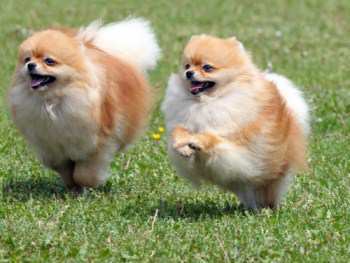Pomeranian Health Issues
Overview
In this section, we will go over different areas of a Pom's body that can let you know if there is a health issue... And then we are going to talk about common problems known to the Pomeranian breed.
DailyChecklist
Daily Checklist
Such conditions as dry nose or slight peeling can often be treated at home with a quality nose butter.
However, deep cracks or any cracks with fluid (pus, blood) warrant a vet examination.
Ears: Odor, red irritated skin on the inside of the flap, thick wax, discharge and/or scratching are clear signs of an ear issue. This can range from fleas to allergies and more.
Breathing:
The rate of breathing can be a good tell-tale signs of health status. Abnormal breathing is sometimes a sign of illness. Breathing problems become more common as dogs age, so regularly taking notice of this can help spot a problem before it progresses too far.
Any rasping, gagging, coughing, wheezing, or other breathing abnormalities should be reported.
Odor from the mouth:
A case of sudden bad breath (with no obvious reason) can be a sign of disease in the body and this calls for a vet visit.
Rosie, at 12 weeks old
Photo courtesy of Donna & Harry Leverett
Prevention
There are a lot of steps that you can take to help keep your Pomeranian healthy.
Some have an immediate affect, as they help to prevent injury. With others, steps you take now will either benefit your Pom or be detrimental to him both short and long term.
1. Choose your Pom's food wisely.
Feed your Pomeranian
the best food possible for both meals and snacks. Read labels carefully.
Keep away from chemical additives; several have been linked to disease including liver disease. Others can cause skin reactions, and still others can cause gastrointestinal distress.
2. Exercise your Pomeranian each day. Indoor activity does not count toward reaching exercise requirements. You will want to take your Pom for purposeful outdoor walking ideally twice per day, for a minimum of 20 minutes.
3. Proof your house no matter what age your Pom is.
Remove all choking and dangerous chewing hazards. Wrap cords with cord concealer.
4. Keep all veterinary wellness appointments.
If you miss one, re-schedule right away. Puppies will see the vet often for vaccinations. Adults should have 1 yearly checkup and seniors should have twice-per-year visits.
5. If you cannot resolve a health issue at home, or if your Pom is clearly sick, do not hesitate to call the vet. Plan for this by budgeting money in advance.
6. Make sure that your Pomeranian receives all needed vaccinations and boosters.
In regard to boosters, your vet can do a titer count to check for antibodies.
7. Do not walk your Pom on leash and collar. Instead, use a harness. This helps prevent neck injury and the very serious issue of collapsed trachea
which is commonly seen with this breed.
8. Never take a chance in the car;
to prevent serious or even fatal injury, always place your Pomeranian into a safe, certified car seat sized for toy dogs.
9. Clean your Pom's teeth each day.
At-home dental care
is vital for preventing painful and sometimes dangerous infections.
10. Be flexible and ready to make changes.
Be ready for seasonal changes to provide tailored care both during the summer
when the weather and hot and the sun is strong and in the wintertime
when it's colder, with wet precipitation but dryer air that can affect the nose, skin, and coat.
Health Issues Seen with the Pomeranian Breed
Just like any other dog breed, the Pomeranian breed is prone to certain canine diseases and health problems. This does not mean that your Pom will develop any of these health issues. A lot of genetic issues are screened out with proper breeding.
However, the following are the health conditions that are commonly seen with Pomeraians. It is a good idea to become familiar with the symptoms, since early detection is a factor for a speedy recovery.
Cataracts - An Eye Disease
Canine cataracts are one of the most frequent problems affecting the eyes of dogs. Toy dogs, such as the Pomeranian, are more prone to this health issue. There are many different forms of canine cataracts and these develop for varied reasons.
This health issue can appear at any age: from right when a Pomeranian is born to an older, senior dog.
Symptoms include:
• A change in the color of the Pomeranian dog’s eye – sometimes blue, gray or white tinting
• The dog will begin to bump into walls, etc as their vision becomes blurred
• Swelling on or around the eyes
• Redness in or around the dog’s eyes
• Rubbing the eyes – this can point pain radiating from the area
If you suspect that your Pomeranian has this health issue, the veterinarian can diagnose this by performing a comprehensive eye exam that includes measuring pressure and checking the back of the eyes as well, after dilating the pupils.
Many cataracts are able to be surgically removed. Early detection is vital, as left untreated, this can often lead to blindness.
Collapsed Trachea
This is a common health issue with Pomeranians; and while some of this is due to genetics, this can be prevented in some cases.
The trachea (windpipe) is supported by rings which are made out of cartilage. With toy breeds, this cartilage is prone to injury. While weakness in the area can be a genetic factor, injury to the neck can also cause this problem.
In regard to trauma related collapsed trachea, this most often is due to the use of a collar when on leash instead of a harness. With just a collar, any time a Pomeranian lunges forward or jumps to the side, all force and pressure is put directly on the fragile neck.
Signs:
- Coughing - This is a particularly unique honking type noise. Some owners may think that it sounds as if the Pom is trying to clear out a hair ball.
- Trouble breathing - A Pom may have a rasp or gasp and struggle to catch his breath
Exercise, excitement, and inhalant irritants can worsen symptoms.
Treatment involves the use of cough suppressants, anti-inflammatory medication, bronchodilators and sometimes antibiotics. While these medications cannot correct the collapsed rings, they can often provide enough relief that a dog is able to have quality of life.
In very serious cases that do not respond to symptomatic treatment, surgery is often performed to stabilize the windpipe.
Prevention: Never have your Pom on leash and collar; always use a properly sized harness.
Skin Problems
This tiny breed is prone to skin issues, the most common being issues with dry and/ or itchy skin. We do have a section that goes into details about this and offers some great tips and advice for treatment and changes you can make that can fix this issue.
See also: Pomeranian Skin Problems for an overview of possible skin issues.
And also see:
Pomeranian Itchiness, which covers the top reasons for itching and exact steps to resolve this.
Distichiasis - An Eyelash Issue
This is a condition in which eyelashes grow out of place; often poking into the dog’s eye(s). This should be treated right away, as prolonged irritation of the lash into the a Pom’s eye can actually cause a tear to the cornea.
Signs include:
- Squinting
- Trying to rub the eye with paws or by rubbing into a wall, pillow or other surface
- The eye(s) may appear irritated, red and/or swollen
You may not be able to see the offending lash, but your dog will feel it.
Treatment is done in usually 1 of 2 ways. The hair may be frozen off or removed with electrolysis. Only in very rare cases, the hair will grow from the duct and if that duct is damaged, surgery may need to be done.
Antibiotics are usually given to prevent any infection. Most dogs recover just fine after treatment.
Chloe, photo courtesy of Holly Beadle
Entropion - An Eyelid Condition
This is a health condition when a dog’s eyelid edge rolls inward. This can happen at any age. More often than not, this happens to the dog’s lower eyelids.
What causes this? Sometimes the Pom’s eye itself moves out of place, causing the lid to roll inward, sometimes an injury or infection causes this. If you suspect this health issues with your Pomeranian, look for:
- Excessive tearing
- Squinting
- Your dog will try to rub the eye with his paws
- A thick mucus-like discharge will come from the eye
- You will actually see the lid rolling back
- Excessive wetness on the fur around the eye
Your veterinarian will be able to make a diagnosis with a thorough eye exam. However, it is recommended that treatment is preformed by a canine optometrist specialist. Treatment will vary according to the severity.
With puppies, the eyelid may be “tacked”, which means that staples will be placed to hold the lid in the correct place. This works best with Pomeranian puppies because they grow so fast. They may outgrow the entropion.
With older dogs, surgery is often done to remove a bit of skin from the dog’s eyelid. In all cases, antibiotics are given.
Hypoglycemia
This is an often sudden drop in blood sugar levels and can be very dangerous and sometimes fatal. This most commonly happens to puppies under the age of 3 months old. The signs can come on quickly:
- Weakness
- Loss of appetite
- Wobbly when walking, lack of coordination
- Trembling, shaking
- Twitching of the muscles
- Seizure and coma in the toward the final stage, which can happen within just hours.
Those with a very young puppy should always have honey in the home and this should be given to the puppy immediately after noticing the symptoms. Many sources cite karo syrup, however this can have a laxative property and we do not recommend this.
The puppy should then immediately be taken to the veterinarian or animal hospital. In moderate to severe cases, IV treatment will be needed to stabilize the dog.
Timon, photo courtesy of Laura Montanez
Luxating Patella – A Health Issue Affecting the Knee Joint
This is found most among toy breed dogs, such as the Pomeranian. This is a condition of the dog’s kneecap. This can occur because of a malformation of the bone or from an injury.
A dog may show symptoms on and off; however without treatment, this health issue usually gets worse and worse.
With this, the kneecap of the dog actually slips out of place. Sometimes, it will become stuck out of place; for 10 minutes, an hour, or even longer.
For many dogs, there will only be a sharp pain at the very moment that it slips.
Owners may notice that the dog lets out a loud yelp, but then seems okay afterward. Oddly, once out of place, the pain often subsides.
Once a Pomeranian has this for several days, swelling will then develop which often leads to on-going discomfort and other signs including:
- The leg may appear to be frozen, held up in the air, as the dog is unable to move it
- Limping or favoring one leg
In some cases, the kneecap can be manipulated into place if it does not slip back by itself. Additional treatment begins with bed rest and anti-inflammatory medication to ease swelling. It's not always easy to keep a Pomeranian from moving around; owners will need to place their Pom in a small indoor canine playpen that limits his movements.
In moderate to severe cases, the issue may worsen; and if this is the case surgery will be performed. The goal will be to fit the kneecap into its proper place so that it will not slide out again. If surgery is recommended yet it is not done, the luxation may happen repeatedly.
Please be aware that Pomeranians that have suffered a luxated patella will be more prone to arthritis in the affected knee(s). For this reason, we recommend giving supplements
to promote joint health and to provide an orthopedic canine bed.
Pituitary Dwarfism
This is a disease common to toy breed dogs. This happens when the dog’s body is unable to produce proper amounts of growth hormones. Several difference issues are thought to cause this, including infection canine disease, cysts in the dog’s glands and/or tumors.
The growth hormones not only affect the growth of a dog, they also control the condition of the dog’s fur, bones and teeth.
Pom puppies with this inherited canine disease will not grow to the proper size.
Teeth will remain very tiny. A Pomeranian with Pituitary Dwarfism will usually not lose his puppy coat and if he does, the adult coat will not grow in thick and profuse as it otherwise would.
Sadly, the lifespan of the dog will be decreased. Treatments are still being developed. Currently the only treatment has found limited success: human growth hormones. Be aware that this is a relatively expensive treatment.
Seizures
A Pomeranian may be born with a seizure condition or may develop one as the dog grows older. Watching a Pom go through an episode can be scary. Learn all of the details about the most common type of Pomeranian seizure here: Pomeranian Seizures
You may also like:
How Old is the Oldest Documented Pomeranian
- A look at a Pom that has endured a host of health issues, bounced back from a broken leg at the age of 18 and is perhaps, one of the cutest senior Poms that exist.


-min-225x335-1920w.jpg)
-min-251x335-1920w.jpg)
-min-335x335-1920w.jpg)


